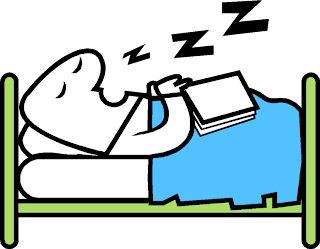I just finished reading Dreamland: Adventures in the Strange Science of Sleep, by David Randall. Here are some of the weirdest things I learned:
- First Sleep, Second Sleep. Before Thomas Edison and his bright, cheap, artificial light, people tended to go to sleep early, at dusk, then wake up for a couple of hours, then go back to sleep until dawn. The length of time from dusk to dawn was just too long to sleep in just one uninterrupted block of time as we are accustomed to doing today. References to "first sleep", "second sleep" and the time between the two sleeps were found across centuries and geographies. In more recent sleep research, subjects who were kept away from artificial light at night consistently start to develop a similar first sleep, second sleep pattern.
- Death from insomnia. There is a rare disease that strikes some people in their 40's that gradually takes away all ability to sleep. The disease is always fatal.
- Separate beds. If quality of sleep was all that mattered to them, most all couples would sleep apart. The ideal would be to be together for romance and then, like couples in the 1950's, go off to separate beds.
- Bad and ordinary dreams. Calvin Hall at Case Western Reserve University collected over 50,000 dream reports from people of all ages and nationalities for over 30 years and sorted these reports into categories. Bottom line: most dreams are pretty much like ordinary reality--they don't defy physics. Also, they are usually at least somewhat unpleasant. Some researchers think this is because your mind is trying to work through some kind of problem. A different book I read once suggests that your mind works through issues when you are dreaming because you are more likely to be using both sides of your brain (the logical side and the intuitive side) when you are dreaming because the Rapid Eye Movements from right to left and back that occur when dreaming engags both sides of the brain. You might, then move toward solutions or perspectives when you are dreaming that would escape you when you are wide awake and dominated by logic.
- Problem solving and sleep. It may or may not be due to dreams, but a variety of experiments show that people working on a problem will make huge gains in their effort after sleeping, as if they were continuing to make progress on the problems while they slept.
- Pugs and people. The only animals that get Sleep Apnea are pugs and people. Dogs with pushed in faces--pugs, bulldogs, etc.--have their tongues deeper into their throats than other dogs or any other animals except human beings. Human tongues are this way because it is part of the arrangement needed to enable speech.
- Bet on the West. When teams from the West Coast play teams from the East Coast, the West Coast usually wins. This is true for most professional teams in the United States. Why? Our bodies are the most awake from 9am-2pm and from 6pm-10pm. To get television viewers, most sporting events will take place between 1pm-7pm or 9pm-11:30pm Eastern Standard Time. The body clocks of the athletes from the East will tend to be "off peak" for most of the game. But the Western athletes will be playing with their body clocks somewhere in the range of 10am-4pm and 6-8:30pm. Mostly peak time.
- Teenagers, Baby Boomers, and the Elderly on Guard. These three age groups tend to sleep at different times of the night, and it may be so that somebody is always on guard. The elderly go to sleep early, then middle aged adults, and last to go to sleep are the teenagers. By the time the teenagers are asleep, the elderly are starting to stir, then the younger adults, and finally the teenagers wake up. Some speculate that this pattern developed as a way to protect human groups sleeping together in the wild because someone was always awake, or at least sleeping very lightly, all night long to alert the others if a Saber Toothed Tiger approached.

No comments:
Post a Comment